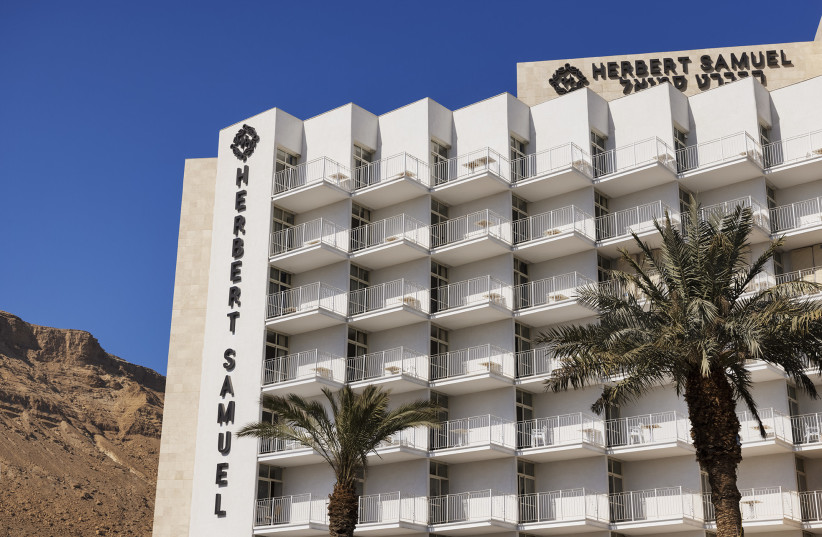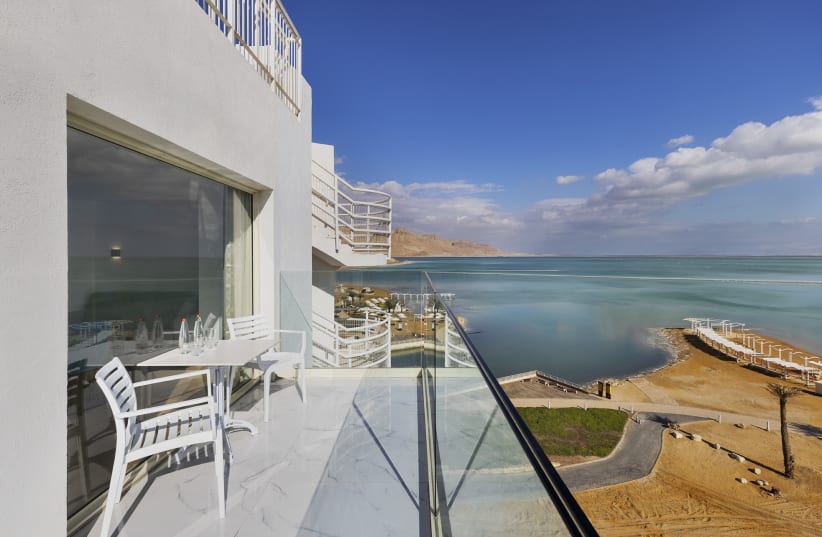The week of Passover is a very popular time for families to take a mini-vacation, since the kids are off school and some workplaces even close down. It’s not always easy to find a nice, reasonably priced place to stay in our tiny country, but since many of us have been hunkering down at home for the last two years due to the pandemic, the thought of finally being able to take a real vacation is extremely enticing.
1. Herbert Samuel Hod Dead Sea Hotel
The strip of hotels in Ein Bokek along the Dead Sea, as well as the promenade and mall area, have been undergoing rejuvenation over the last few years, and a new hotel has even opened up: Herbert Samuel Hod Dead Sea Hotel, which belongs to the Nakash Brothers Group. This is the second hotel the group has opened in the Dead Sea area, the first one being Milos, a Greek-style boutique hotel just next door.
The Dead Sea is one of Israel’s greatest natural treasures, and yet the strip of hotels has had a difficult time taking off as a popular tourist destination. For this reason, it is especially exciting when a new hotel opens up there.
The new Herbert Samuel Hod Hotel was built where the Hod Hotel used to be. It has 211 rooms, most of which have a balcony with a sea view or a view of the unique mountainous landscape for which the region is famous. Some of the rooms have private pools, which are perfect for couples looking for an intimate getaway.


The Herbert Samuel Spa has 16 treatment rooms, a dry sauna, a steam room, a hammam Turkish bath and a gym. There is a salt-water pool, a sulfur pool and a jacuzzi. Just a few steps from the spa, you’ll find an outdoor pool, a bar and a restaurant. In addition, from the hotel’s spacious dining room, which serves three buffet-style meals a day, guests can sit overlooking the Dead Sea. If you manage to be there at sunset, or in the early morning as the mountains slowly become visible, try to get a table by the large windows so you can truly enjoy the view.
Once you’ve enjoyed all the amenities inside the hotel, it’s time to get outside and take a walk along the beautiful new promenade, which has many spots along the way where you can rest and enjoy the view. I recommend walking all the way to the “salt promenade,” which juts out towards the center of the water. This allows you to view some of the interesting salt formations, which up close look like mushrooms.
If, like me, you found these formations fascinating, then I recommend continuing another 500 meters south of the public beach, where you’ll come upon 15 salt mushrooms which you can reach by walking into the water. Forming a 400-meter-long path, they reach up to a meter high and can be viewed from the beach. To reach the first mushroom, which is about 30 meters from the beach, you’ll need to walk into the water up to about waist high.
Prices: Start at NIS 1,000 a night per room (2 people) including breakfast, and NIS 1,380 for two for half-board.
What else is there to do in the area?
2. Nahal Bokek
Many people who vacation at the Dead Sea take advantage of the pools, the beach, the dining hall and the comfy hotel rooms, but they don’t venture outdoors much. In my opinion, this is a shame since there’s lots to see out in nature, and one there’s specific trail that I especially love.
Moreover, this is the best time of year to visit the Dead Sea area, since the weather is still relatively cool. This area has an incredible combination of beautiful mountain views, flowing water in Bokek Stream and lots of shady rest areas.
Walking along Nahal Bokek is easy and appropriate for the whole family, and at the end, you will reach Ein Bokek, a gorgeous spring that brings me joy every single time I go there. Nahal Bokek is only 15 meters long, making it the shortest stream in the Judean Desert. The flowing water eventually leads to a gushing waterfall, with a large pool at the bottom.
Visitors can pick either the short trail or the long trail; the latter is geared toward more experienced hikers.
Directions: Ein Bokek in Waze.
3. Scrolls Trail
A new trail that was recently opened to the public by the Israel Parks Authority is the Scrolls Trail, a beautiful nature walk near the Qumran Caves, that includes gorgeous views of the surrounding mountains and lots of caves hidden in the sides of the cliff. The famous 25 Dead Sea Scrolls, some of which had been preserved almost in their entirety, were uncovered in some of these caves.
The 1.6-kilometer trail, which is appropriate for the whole family, begins at Kibbutz Kalia. From there, you can follow the green trail markers. If you’re looking for a shorter walk, you can join the path near the forest surrounding the kibbutz’s cemetery. For this path, follow the blue trail markers, which at some point will merge with the green path, and leads to Qumran National Park. If you prefer an even shorter walk that does not include any climbing, you can begin along the Scrolls Trail at Qumran National Park.
As you’re walking along the green path, take note of all the jagged cliffs, many of which have caves dug out inside of them. At one point along the way, you’ll reach a dry riverbed, that had clearly been washed out with force during the winter rains. Find the bench made of stone, take a seat and enjoy the impressive view while you rest for a moment.
Then, when you’re ready to move on, continue on the path until you reach a monument shaped like a drilling device that was placed on the side of the path to tell the story of how wells were dug in the region before Israel became an official state. In addition, from this spot, you have a direct view of the cave in which the scrolls were discovered.
If you’d like to learn more details about the Qumran Scrolls, I recommend visiting Qumran National Park.
Directions: Drive along Road 90 towards the Dead Sea. At Kalia Intersection, turn toward the west. Continue driving alongside Kibbutz Kalia, then follow the signs. ■
Translated by Hannah Hochner.
